普华永道《商业计划书(Business Plan)经典培训教程》(41页)
- 格式:pdf
- 大小:619.13 KB
- 文档页数:41



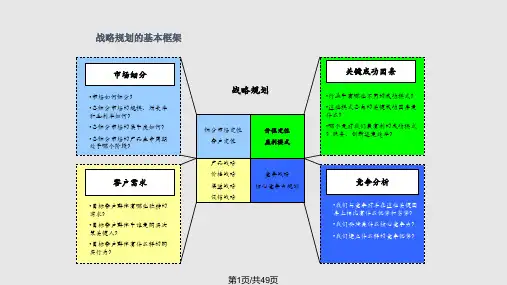
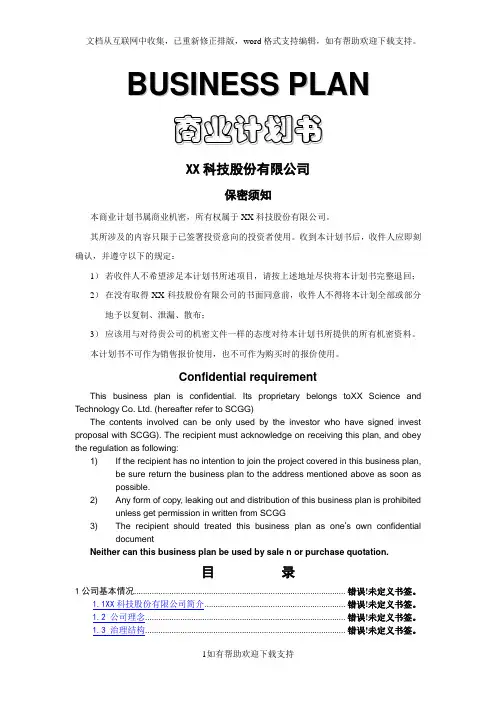
B U S I N E S S P L A N商业计划书XX科技股份有限公司保密须知本商业计划书属商业机密,所有权属于XX科技股份有限公司。
其所涉及的内容只限于已签署投资意向的投资者使用。
收到本计划书后,收件人应即刻确认,并遵守以下的规定:1)若收件人不希望涉足本计划书所述项目,请按上述地址尽快将本计划书完整退回;2)在没有取得XX科技股份有限公司的书面同意前,收件人不得将本计划全部或部分地予以复制、泄漏、散布;3)应该用与对待贵公司的机密文件一样的态度对待本计划书所提供的所有机密资料。
本计划书不可作为销售报价使用,也不可作为购买时的报价使用。
Confidential requirementThis business plan is confidential. Its proprietary belongs toXX Science and Technology Co. Ltd. (hereafter refer to SCGG)The contents involved can be only used by the investor who have signed invest proposal with SCGG). The recipient must acknowledge on receiving this plan, and obey the regulation as following:1) If the recipient has no intention to join the project covered in this business plan,be sure return the business plan to the address mentioned above as soon aspossible.2) Any form of copy, leaking out and distribution of this business plan is prohibitedunless get permission in written from SCGG3) The recipient should treated this business plan as one’s own confidentialdocumentNeither can this business plan be used by sale n or purchase quotation.目录1公司基本情况................................................................................................ 错误!未定义书签。

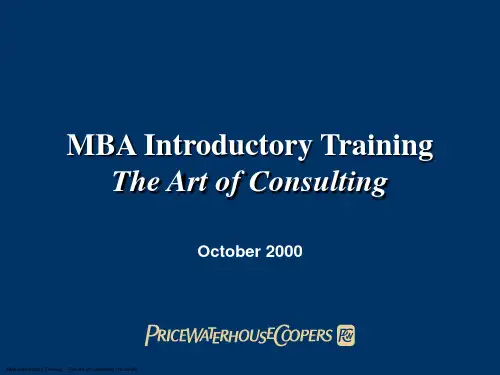

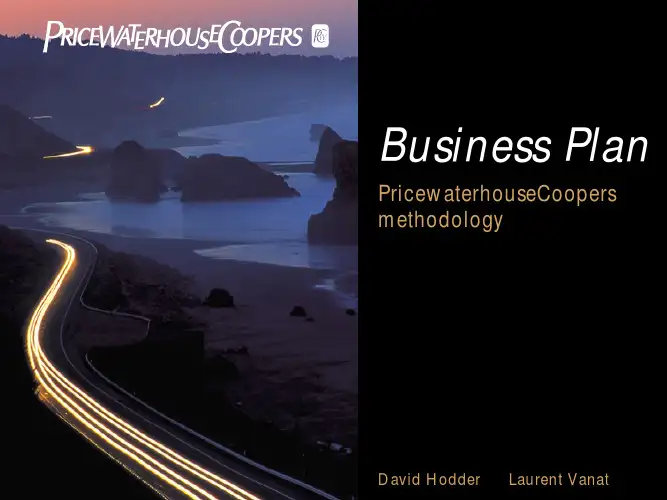
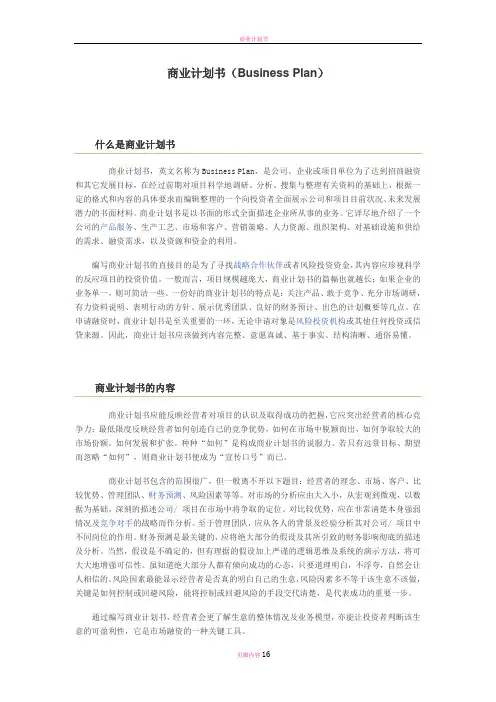
商业计划书(Business Plan)什么是商业计划书商业计划书,英文名称为Business Plan,是公司、企业或项目单位为了达到招商融资和其它发展目标,在经过前期对项目科学地调研、分析、搜集与整理有关资料的基础上,根据一定的格式和内容的具体要求而编辑整理的一个向投资者全面展示公司和项目目前状况、未来发展潜力的书面材料。
商业计划书是以书面的形式全面描述企业所从事的业务。
它详尽地介绍了一个公司的产品服务、生产工艺、市场和客户、营销策略、人力资源、组织架构、对基础设施和供给的需求、融资需求,以及资源和资金的利用。
编写商业计划书的直接目的是为了寻找战略合作伙伴或者风险投资资金,其内容应珍视科学的反应项目的投资价值。
一般而言,项目规模越庞大,商业计划书的篇幅也就越长;如果企业的业务单一,则可简洁一些。
一份好的商业计划书的特点是:关注产品、敢于竞争、充分市场调研,有力资料说明、表明行动的方针、展示优秀团队、良好的财务预计、出色的计划概要等几点。
在申请融资时,商业计划书是至关重要的一环,无论申请对象是风险投资机构或其他任何投资或信贷来源。
因此,商业计划书应该做到内容完整、意愿真诚、基于事实、结构清晰、通俗易懂。
商业计划书的内容商业计划书应能反映经营者对项目的认识及取得成功的把握,它应突出经营者的核心竞争力;最低限度反映经营者如何创造自己的竞争优势,如何在市场中脱颖而出,如何争取较大的市场份额,如何发展和扩张。
种种“如何”是构成商业计划书的说服力。
若只有远景目标、期望而忽略“如何”,则商业计划书便成为“宣传口号”而已。
商业计划书包含的范围很广,但一般离不开以下题目:经营者的理念、市场、客户、比较优势、管理团队、财务预测、风险因素等等。
对市场的分析应由大入小,从宏观到微观,以数据为基础,深刻的描述公司/ 项目在市场中将争取的定位。
对比较优势,应在非常清楚本身强弱情况及竞争对手的战略而作分析。
至于管理团队,应从各人的背景及经验分析其对公司/ 项目中不同岗位的作用。

Business plan for a new businessThe business plan consists of a narrative and several financial worksheets. The narrative template is the key to the business plan. It contains more than 150 questions divided into several sections. Omit any questions that do not apply to your type of business. When you have finished writing your first draft, you will have a collection of small essays on the various aspects of the business plan. The next stage is to edit them into a smooth-flowing narrative.The real value of creating a business plan is not in having the finished plan in your hand; rather, the value lies in the process of researching and thinking about your business in a systematic way. The act of planning helps you to think things through thoroughly, study and research if you are not sure of the facts, and look at your ideas critically. It takes time now, but will help avoid costly, perhaps disastrous, mistakes later.This business plan is a specific model suitable for high-tech businesses. Before you begin, look at the 1st section Tailoring the plan. It has tips for fine-tuning your plan to make an effective presentation to investors. If this is why you’re creating your plan, pay particular attention to your writing style. You will be judged by the quality and appearance of your work as well as by your ideas.It typically takes several weeks to complete a good plan. Most of that time is spent in researching and revising your ideas and assumptions. But this is the value of the process. So make time to do the job properly. Those who do so never regret the effort. And finally, be sure to keep detailed notes on your sources of information and on the assumptions underlying your financial data.Tailoring the planThe generic business plan presented should be modified to suit your specific type of business and the audience for which the plan is written.For raising capitalFor investorsInvestors have a different perspective. They are looking for dramatic growth, and they expect to share in the rewards:o Funds needed short-termo Funds needed in two to five years’ timeo How the company will use the funds, and what this will accomplish for growtho Estimated return on investmento Exit strategy for investors (buyback, sale or IPO)o Proportion of ownership that you will give up to investorso Milestones or conditions that you will accepto Financial reporting to be providedo Involvement of investors on the board or in managementFor type of businessHigh-tech companiesEconomic outlook for the industryWill the company have information systems in place to manage rapidly changing prices, costs and markets?Will you be on the cutting edge with your products and services?What is the status of research and development? And what is required to:o Bring product/service to market?o Keep the company competitive?How does the company:o Protect intellectual property?o Avoid technological obsolescence?o Supply necessary capital?o Retain key personnel?High-tech companies sometimes have to operate for a long time without profits and sometimes even without sales. If this fits your situation, a banker probably will not want to lend to you. Venture capitalists may invest, but your case must be very good. You must do longer-term financial forecasts to show when profit take-off is expected to occur. And your assumptions must be well documented and well argued.Business planOWNERSYour Business NameDateE-MailWebpageTable of contents1.Executive summary (6)2.Introduction to the Company and its Management (7)2.1Company Overview (7)2.2Organisational Structure (7)2.3The Management Team (7)2.4Advisory Board (7)2.5Proposed Management Compensation (7)2.6Headcount Forecast (7)3.Products and Services Description (8)3.1Products and Technologies Introduction (8)3.2Detailed Development Plan (8)3.2.1Product Roadmaps (8)3.2.2Development Stages (8)3.3Future Applications (8)4.Marketing Analysis (9)4.1Market Trend (9)4.2Market Segmentation (10)4.3Market Gap (Unique Selling Point) (10)4.4Competitive Analysis (10)5.Business Model (12)5.1Core Competence (12)5.2SWOT Analysis (12)5.3Marketing Plan (12)5.4Sales Forecast (14)5.4.1Realistic Scenario (15)5.4.2Optimistic Scenario (15)5.4.3Pessimistic Scenario (15)6.Risk Analysis and Management (16)6.1Technical Risk (16)6.1.1Technology Safety (16)6.1.2Product Quality (16)6.1.3Delay (16)6.2Competition Risk (16)6.3Management of Growth (17)6.4Market Risk (17)7.Financial Plan (18)7.1Summary of Assumptions (18)7.1.1Revenue (18)7.1.2Direct Variable Costs (18)7.1.3Fixed Asset Investment (18)7.1.4Human Resources (18)7.1.5Services Rendered by 3rd Party (18)7.1.6Infrastructure and Operational Costs (18)7.1.7Marketing (18)7.1.8Tax (18)7.2Break-Even Position (18)7.3Projected profits (19)7.4Investment and Return (19)7.5Financial Statements (19)8.Business Feasibility and Impact in the UK and China (20)9.References (21)10.Appendices (22)Executive summaryWrite this section last.We suggest that you make it no more than two pages long.Include everything that you would cover in a five-minute interview.Explain the fundamentals of the proposed business: What will your product be? Who will your customers be? Who are the owners? What do you think the future holds for your business and your industry?Make it enthusiastic, professional, complete and concise.If proposing for an investment, state clearly how much you want, precisely how you are going to use it, and how the money will make your business more profitable, thereby ensuring repayment.Paragraph headings can be used if they identify the purpose of each paragraph. (example below)Company and Management (Team)Product/Service DescriptionMarket AnalysisCompany StrategyRisk AnalysisFinancial PlanInvestment PropositionIntroduction to the Company and its Management2.1 Company OverviewWhat business will you be in? What will you do?Mission Statement: Many companies have a brief mission statement, usually in 30 words or fewer, explaining their reason for being and their guiding principles. If you want to draft a mission statement, this is a good place to put it in the plan.2.2 Organisational StructureIf you’ll have more than 10 employees, create an organizational chart showing the management hierarchy and who is responsible for key functions.Include position descriptions for key employees. If you are seeking loans or investors, include resumes of owners and key employees.2.3 The Management TeamWho will manage the business on a day-to-day basis? What experience does that person bring to the business? What special or distinctive competencies? Is there a plan for continuation of the business if this person is lost or incapacitated?2.4 Advisory BoardList members of management advisory board and their short resume/CV.2.5 Proposed Management CompensationIf the management team are willing to reduce their compensation in the first year of business2.6 Headcount ForecastNumber of employees of each departments and the total in the next 5 years. (tables preferred)Products and Services Description3.1 Products and Technologies IntroductionDescribe in depth your products or services (technical specifications, drawings, photos, sales brochures and other bulky items belong in the Appendices).What factors will give you competitive advantages or disadvantages? Examples include level of quality or unique or proprietary features.What are the cost, fee or commission structures of your products or services?Don’t forget to include the current Patent Status.3.2 Detailed Development Plan3.2.1 Product RoadmapsList and describe product type and service of all categories, what they do, when they are available, and the timeline of design, prototype, sample promotion etc. (tables and figures are encouraged)3.2.2 Development StagesWrite down the stages used to measure the stepping successes (deliverables, milestones) of the whole company according to the development plan.3.3 Future ApplicationsList and describe potential applications.Marketing AnalysisNo matter how good your products and services are, the venture cannot succeed without effective marketing. This begins with careful and systematic research. It is very dangerous to assume that you already know about your intended market. You need to do market research to make sure you are on track. Use the business planning process as your opportunity to uncover data and to question your marketing efforts. Your time will be well spent.There are two kinds of market research: primary and secondary.Secondary research means using published information such as industry profiles, trade journals, newspapers, magazines, census data, and demographic profiles. This type of information is available in public libraries, industry associations, chambers of commerce, from vendors who sell to your industry, and from government agencies.Primary research means gathering your own data. For example, you could do your own traffic count at a proposed location, use the yellow pages to identify competitors, and do surveys or focus-group interviews to learn about consumer preferences. Professional market research can be very costly, but there are many books that show small business owners how to do effective research themselves.In your marketing plan, be as specific as possible; give statistics, numbers, and sources. The marketing plan will be the basis, later on, of the all-important sales projection.4.1 Market TrendDescribe your industry. Is it a growth industry? What changes do you foresee in the industry, short term and long term? How will your company be poised to take advantage of them?Facts about your industry:What is the total size of your market?What percent share of the market will you have? (This is important only if you think you will be a major factor in the market.)Current demand in target market.Trends in target market—growth trends, trends in consumer preferences, and trends inproduct development.4.2 Market SegmentationShow the understanding of the market segments (sizes, volume growth, revenue growth)4.3 Market Gap (Unique Selling Point)Analyze the current market and identify and explain that there might be a gap, a weak/missing segment of the market for your particular product. And describe growth potential and opportunity for a business of your type and size.4.4 Competitive AnalysisWhat products and companies will compete with you? List your major competitors:Will they compete with you across the board, or just for certain products and customers or in certain locations? Will you have important indirect competitors? (For example, video rental stores compete with cinemas, although they are different types of businesses.)How will your products or services compare with the competition?You can use the Competitive analysis table below to compare your company with your two most important competitors. The first column lists key competitive factors. Since these vary from one industry to another, you may want to customize the list of factors.In the column labeled Me, state honestly how you think you will be perceived in customers' minds. Then check whether you think this factor will be a strength or a weakness for you. Sometimes it is hard to analyse our own weaknesses. Try to be very clear here. Better yet, get somebody else to assess you. This can be a real eye-opener. And remember that you cannot be all things to all people. In fact, trying to be causes many business failures because their efforts become scattered and diluted. You want an honest assessment of your firm's strong and weak points.Now analyse each major competitor. In a few words, state how you think they compare with you. In the final column, estimate the importance of each competitive factor to the customer. 1 = critical; 5 = not very important.Table 1: Competitive analysisNow, write a short paragraph stating your competitive advantages and disadvantages.Business ModelHow will you develop your company, through alliance and co-development or …?List and explain them step by step.5.1 Core CompetenceDescribe your most important company strengths and core competencies. What factors will make the company succeed? What do you think your major competitive strengths will be? What background experience, skills, and strengths do you personally bring to this new venture?5.2 SWOT AnalysisStrength: Cost, size, energy saving, eco-friendly, robustness, future development…Weakness: Immature, suppliers…Opportunities: Political Opportunities, market opportunities, co-operation opportunities.Threats: Competitors, Intellect Property, supplier chain.5.3 Marketing PlanNow outline a marketing strategy that is consistent with your niche.Marketing strategies according to the 4P theories, namely Product, Price, Promotion and Place. (The 5th P –People is the whole reason for the services industry to be doing very well OR even for improving the service experience in a Product industry is because they all target 'People'.)Product StrategyList all of your major products or services.For each product or service:Describe the most important features. What is special about it?Describe the benefits. That is, what will the product do for the customer?Note the difference between features and benefits, and think about them. For example, a house that gives shelter and lasts a long time is made with certain materials and to a certain design; those are its features. Its benefits include pride of ownership, financial security, providing for the family, and inclusion in a neighborhood. You build features into your product so that you can sell the benefits.What after-sale services will you give? Some examples are delivery, warranty, service contracts, support, follow-up, and refund policy.PricingExplain your method or methods of setting prices. For most small businesses, having the lowest price is not a good policy. It robs you of needed profit margin; customers may not care as much about price as you think; and large competitors can under price you anyway. Usually you will do better to have average prices and compete on quality and service.Does your pricing strategy fit with what was revealed in your competitive analysis?Compare your prices with those of the competition. Are they higher, lower, the same? Why?How important is price as a competitive factor? Do your intended customers really make their purchase decisions mostly on price?What will be your customer service and credit policies?PromotionHow will you get the word out to customers?Advertising: What media, why, and how often? Why this mix and not some other?Have you identified low-cost methods to get the most out of your promotional budget?Will you use methods other than paid advertising, such as trade shows, catalogs, dealer incentives, word of mouth (how will you stimulate it?), and network of friends or professionals?What image do you want to project? How do you want customers to see you?In addition to advertising, what plans do you have for graphic image support? This includes things like logo design, cards and letterhead, brochures, signage, and interior design (if customers come to your place of business).Should you have a system to identify repeat customers and then systematically contact them?Promotional BudgetHow much will you spend on the items listed above?Before startup? (These numbers will go into your startup budget.)Ongoing? (These numbers will go into your operating plan budget.)Proposed Location/PlaceProbably you do not have a precise location picked out yet. This is the time to think about what you want and need in a location. Many startups run successfully from home for a while.You will describe your physical needs later, in the Operational Plan section. Here, analyze your location criteria as they will affect your customers.Is your location important to your customers? If yes, how?If customers come to your place of business:Is it convenient? Parking? Interior spaces? Not out of the way?Is it consistent with your image?Is it what customers want and expect?Where is the competition located? Is it better for you to be near them (like car dealers or fast-food restaurants) or distant (like convenience-food stores)?Distribution ChannelsHow do you sell your products or services?Retail, Direct (mail order, Web, catalog), Wholesale, Your own sales force, Agents, Independent representatives, Bid on contracts5.4 Sales ForecastNow that you have described your products, services, customers, markets, and marketing plans in detail, it’s time to attach some numbers to your plan. Use a sales forecast spreadsheet to prepare a quarter-by-quarter projection. The forecast should be based on your historical sales, the marketing strategies that you have just described, your market research, and industry data, if available.You may want to do two forecasts: 1) a "best guess", which is what you really expect, and 2) a "worst case" low estimate that you are confident you can reach no matter what happens.Remember to keep notes on your research and your assumptions as you build this sales forecast and all subsequent spreadsheets in the plan. This is critical if you are going to present it to funding sources.5.4.1 Realistic Scenario5.4.2 Optimistic Scenario5.4.3 Pessimistic ScenarioRisk Analysis and Management6.1 Technical Risk6.1.1 Technology SafetySafety issue involved in the technology used and proposed solutions.6.1.2 Product QualityWhat are the quality issues proposed solutions6.1.3 DelayWhat delays are likely to happen at which stage and proposed solutions.6.2 Competition RiskWhat are the competition risks from existing and new comers and proposed solutions, such as IP protection, development of new technologies.What barriers to entry do you face in entering this market with your new company? Some typical barriers are:High capital costsHigh production costsHigh marketing costsConsumer acceptance and brand recognitionTraining and skillsUnique technology and patentsUnionsShipping costsTariff barriers and quotasAnd of course, how will you overcome the barriers?How could the following affect your company?Change in technologyChange in government regulationsChange in the economyChange in your industry6.3 Management of GrowthHow will the company manage its own growth and problems resulted.6.4 Market RiskMarket risks (such as cost fluctuation) and proposed solutions.Financial PlanYour financial will come from a sales forecast in which you forecast sales, cost of goods sold, expenses, and profit month-by-month for one year.Profit projections should be accompanied by a narrative explaining the major assumptions used to estimate company income and expenses.Research Notes: Keep careful notes on your research and assumptions, so that you can explain them later if necessary, and also so that you can go back to your sources when it’s time to revise your plan.Tables and figures are encouraged.7.1 Summary of AssumptionsList assumptions made for financial projection. (break-even calculation)Below are the costs, revenue and investments for the cash flow.7.1.1 Revenue7.1.2 Direct Variable Costs7.1.3 Fixed Asset Investment7.1.4 Human Resources7.1.5 Services Rendered by 3rd Party7.1.6 Infrastructure and Operational Costs7.1.7 Marketing7.1.8 Tax7.2 Break-Even PositionA break-even analysis predicts the sales volume, at a given price, required to recover total costs. In other words, it’s the sales level that is the dividing line between operating at a loss and operating at a profit.Expressed as a formula, break-even is:Breakeven Sales = Fixed Costs1- Variable Costs(%)(Where fixed costs are expressed in dollars, but variable costs are expressed as a percent of total sales.)7.3 Projected profitsMany hi-tech business owners think of the 5 year profit and loss projection as the centerpiece of their plan. This is where you put it all together in numbers and get an idea of what it will take to make a profit and be successful.7.4 Investment and ReturnExplain how the company will be financed, three rounds for example. Describe the targeted investors, how much is needed, how much share the company is willing to exchange (with conditions), and how the investment will be spent. (A table is normally used to summarize the proposal.)7.5 Financial StatementsA balance sheet is one of the fundamental financial reports that any business needs for reporting and financial management. A balance sheet shows what items of value are held by the company (assets), and what its debts are (liabilities). When liabilities are subtracted from assets, the remainder is o wners’ equity.Use a startup expenses and capitalization spreadsheet as a guide to preparing a balance sheet at the end of each year for 5 years. Then detail how you calculated the account balances on your opening day balance sheet.Business Feasibility and Impact in the UK and ChinaYour ability to identify the viability of your business both in the UK and China are crucial to the success of your business.How can your business best leverage both the resources of the UK and China? Why would your business benefit from the current business climate in China and UK?What are the culture specific considerations of your technology/service?How will the technology/services benefit the UK and the Chinese society as a whole?China and the UK both have their own concerns and strengths. How the company is going to use Chin a and UK’s strengths, not the weaknesses.China’s Demands (Government policy)China’s Strength (Manufacturing capability and market size)UK Demands (Government policy, concern on spending cuts etc.)UK Strengths (Research Ability, good IP protection, European market)ReferencesAppendicesInclude details and studies used in your business plan. For example: Brochures and advertising materialsIndustry studiesBlueprints and plansMaps and photos of locationMagazine or other articlesDetailed lists of equipment owned or to be purchasedCopies of leases and contractsLetters of support from future customersAny other materials needed to support the assumptions in this plan Market research studiesList of assets available as collateral for a loan。
KPMG内部培训教程(带特殊条款)KPMG内部培训教程一、引言KPMG作为全球知名的会计师事务所之一,一直以来都致力于为员工提供全面、系统的内部培训。
本教程旨在帮助新员工快速融入公司,提升专业技能,为公司的持续发展贡献力量。
本文将详细介绍KPMG内部培训教程的结构、内容和特点,以便让读者更好地了解KPMG的培训体系。
二、培训目标1.使新员工尽快熟悉公司的文化、价值观和业务领域;2.提升员工的专业技能,提高工作效率;3.培养员工的团队协作精神和沟通能力;4.增强员工对企业社会责任的认识。
三、培训内容1.企业文化及价值观培训:新员工入职后,需要了解KPMG的企业文化、价值观和发展历程。
通过培训,使员工深刻理解公司文化,将公司的价值观融入到日常工作中。
2.专业技能培训:根据员工的岗位需求,提供相应的专业技能培训。
包括财务、审计、税务、咨询等领域的专业知识,以及各类软件操作技能。
培训形式有内部讲师授课、外部专家讲座、在线学习等。
3.团队协作与沟通培训:通过团队建设、沟通技巧培训等活动,提高员工的团队协作精神和沟通能力。
使员工能够更好地与同事、客户进行有效沟通,提高工作效率。
4.企业社会责任培训:KPMG注重企业社会责任,通过培训使员工认识到企业社会责任的重要性,并在工作中积极践行。
培训内容包括环境保护、公益事业、合规经营等方面。
四、培训方式1.面授培训:由内部讲师或外部专家进行面对面授课,结合案例分析、互动讨论等形式,使员工更好地吸收知识。
2.在线学习:通过KPMG内部学习平台,提供丰富的在线课程资源,员工可根据自己的时间和进度进行学习。
3.实践操作:结合实际工作,让员工在实际操作中提升专业技能。
如参与审计项目、咨询项目等。
4.师徒制度:为新员工指定一位经验丰富的导师,进行一对一辅导,帮助新员工快速成长。
五、培训评估为确保培训效果,KPMG对内部培训进行严格评估。
评估内容包括:1.培训满意度:通过问卷调查、访谈等方式,了解员工对培训的满意度,及时调整培训内容和方式。
▲怎样写好商业计划书(总4页)-CAL-FENGHAI.-(YICAI)-Company One1 -CAL-本页仅作为文档封面,使用请直接删除2怎样写好商业计划书中国产权交易所网美国一位着名风险投资家曾说过,“风险企业邀人投资或加盟,就象向离过婚的女人求婚,而不象和女孩子初恋。
双方各有打算,仅靠空口许诺是无济于事的。
”对于正在寻求资金的风险企业来说,商业计划书就是企业的电话通话卡片。
商业计划书的好坏,往往决定了投资交易的成败。
对初创的风险企业来说,商业计划书的作用尤为重要,一个酝酿中的项目,往往很模糊,通过制订商业计划书,把正反理由都书写下来,然后再逐条推敲。
风险企业家这样就能对这一项目有更清晰的认识。
可以这样说,商业计划书首先是把计划中要创立的企业推销给风险企业家自己。
其次,商业计划书还能帮助把计划中的风险企业推销给风险投资家,公司商业计划书的主要目的之一就是为了筹集资金。
因此,商业计划书必须要说明: (1)创办企业的目的----为什么要冒风险,花精力、时间、资源、资金去创办风险企业 (2)创办企业所需的资金----为什么要这么多的钱为什么投资人值得为此注入资金对已建的风险企业来说,商业计划书可以为企业的发展定下比较具体的方向和重点,从而使员工了解企业的经营目标,并激励他们为共同的目标而努力。
更重要的是,它可以使企业的出资者以及供应商、销售商等了解企业的经营状况和经营目标,说服出资者(原有的或新来的)为企业的进一步发展提供资金。
正是基于上述理由,商业计划书将是风险企业家所写的商业文件中最主要的一个。
那么,如何制订商业计划书呢一、怎样写好商业计划书那些既不能给投资者以充分的信息也不能使投资者激动起来的商业计划书,其最终结果只能是被扔进垃圾箱里。
为了确保商业计划书能起作用,风险企业家应做到以下几点: 1.关注产品在商业计划书中,应提供所有与企业的产品或服务有关的细节,包括企业所实施的所有调查。
这些问题包括:产品正处于什么样的发展阶段它的独特性怎样企业分销产品的方法是什么谁会使用企业的产品,为什么产品的生产成本是多少,售价是多少企业发展新的现代化产品的计划是什么把出资者拉到企业的产品或服务中来,这样出资者就会和风险企业家一样对产品有兴趣。